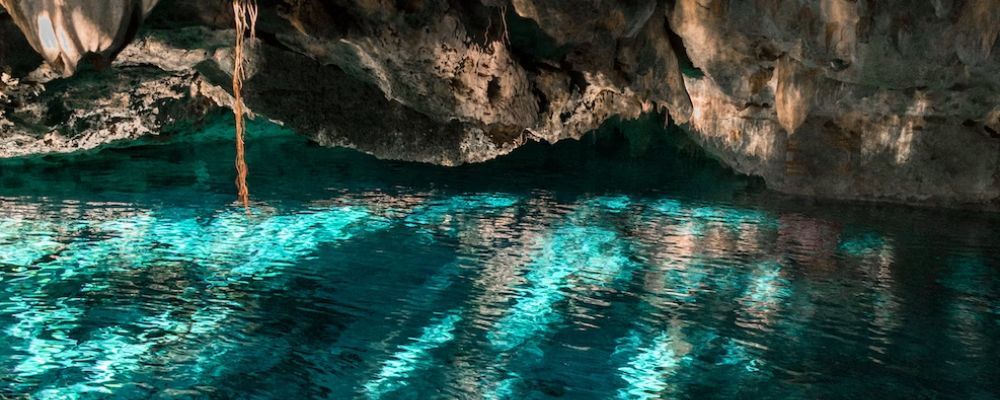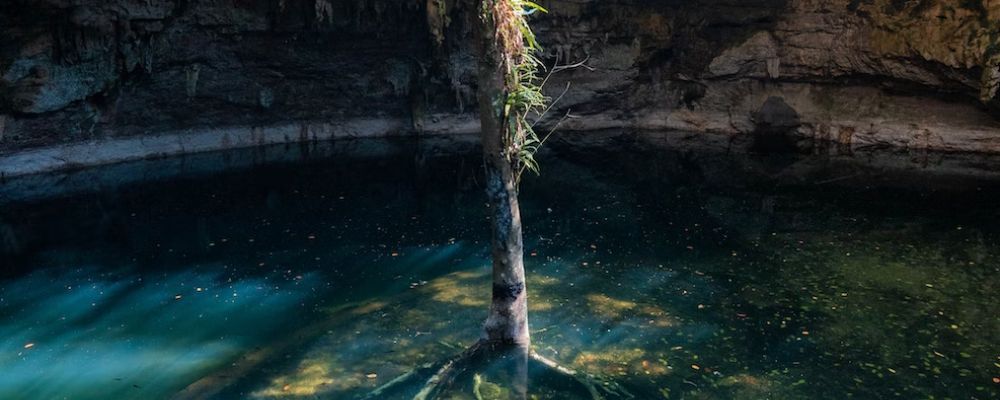In previous articles, we have told you about the most important theme parks to visit in Cancun and some of its shopping malls. This time it is time to talk about nature.
You may have seen some pictures of these crystal clear water wells before since cenotes are a significant tourist attraction in Mexico. As the years go by, more and more people are curious to know and explore them, since a cenote, besides being a natural beauty, has a lot of history.
That is why the eTransfers team wants to share more information about cenotes with you so that the next time you book a Cancun Tours, you will know more about these natural phenomena that will make you fall in love with them.
The word "cenote" comes from the Mayan tz'onot, which means: a cavern with water. It is said that the formation of the cenotes was partly due to the meteorite that contributed to the extinction of the dinosaurs. Upon impact, the meteor formed a series of empty caves and gave rise to the cenotes after the last ice age.
That is why most of the cenotes in Mexico are located in the south of the country since this is where the meteorite is believed to have fallen. Besides, we must remember that it is an affluent area well known for its cultural and linguistic diversity since there are also settlements of one of Mexico's most important original cultures, the Mayas.
The cenotes in pre-Columbian Mexico were used for ceremonies and rituals, making them symbolic and mystical places. Some myths assure that through them, it was possible to reach the underworld of the Mayan people.

A cenote is not only water well but has other characteristics that make it unique. It has crystalline water that can be blue, completely green, or a combination of both.
They are usually freshwater, have no waves which transmit a deep and relaxing stillness, their water is very fresh, and there are usually trees or nature around them that cover them.
Some are very deep, and others cover only the knees of the people who swim in them. Most have stalactites (on the ceiling), stalagmites (on the floor), and columns. The truth is that they are simply beautiful and unique.
As the freshwater mixed with the salt from the sea, it began to impact the limestone rock, gradually dissolving it and creating holes in it. Time passed, and these holes started to expand their territory, originating tunnels and water passages similar to the rivers on the surface.
So there are different types in which you can have other adventures in cenotes, from the most spiritual to those that trigger your adrenaline.
Their walls are cylindrical, which allows the sun to enter, although they do not necessarily have to be cylindrical. Other open cenotes look like lagoons and have no walls, just crystal-clear water. Cenote Azul, located in the Riviera Maya, is an open cenote since it is exposed to the surface, and the sun's rays fall on the water.

These cenotes are the youngest, the cavern covers the water, but this does not mean that their waters are not turquoise or emerald green like the open ones. Some communities have installed lights inside these cenotes so tourists and locals feel safe and calm. The beautiful Cenote Choo Ha is one of those that fall into this category and has attracted thousands of tourists.

They are neither young nor old because the water has yet to be left out in the open. However, a part of them is. This allows light to enter the cenote and observe its beauty. Some even have water so crystal clear that it is possible to see their interior's flora and fauna. An example of this type of cenote is Cenote Ik Kil, which is impressive since, from the entrance, you can appreciate the beauty of the place.

It is very accessible, as it is in the middle of downtown Valladolid, where there are many activities you can do. It is a semi-open cenote that benefits from having a lot of natural light since several parts of the cave roof have partially collapsed. It has a large pool suitable for all kinds of activities.
It has many ring-shaped opening that offers plenty of space for exploration and other activities. Something incredible about the cenote is that the afternoon sun illuminates it giving a spectacular view of the waters and the place. The best thing about this cenote is the beautiful cave formations, the wide variety of incredible stalactites and stalagmites, the area's lighting, and the water's depth.
It is located south of Playa del Carmen, near the coastal road. It is famous because it has no roof, giving way to an opening that receives a lot of sunlight that spreads through the jungle canopy on top.
It has a large selection of freshwater pools with a stunning turquoise color, making this cenote one of the most beautiful near Cancun.
? Check what the weather will be like on the day of your visit. If it is cloudy, it will be best to go to an enclosed cenote to enjoy the experience better.
? Wear a bathing suit.
? Use mosquito repellent.
Bring enough money.
If you have diabetes or asthma, it is essential to consult the activities to be carried out beforehand and take the necessary measures.
If you visit Cancun, take advantage of the opportunity to visit its beautiful cenotes. Look for tours that offer safety and comfort. Reliable transportation from the airport can make a significant difference in the quality of your trip. Rely on professionals like Cancun Tours.